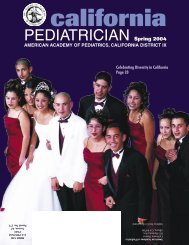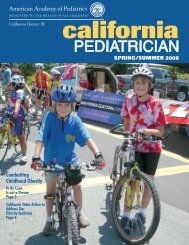PEDIATRICIAN Spring 2003 - AAP-CA
PEDIATRICIAN Spring 2003 - AAP-CA
PEDIATRICIAN Spring 2003 - AAP-CA
You also want an ePaper? Increase the reach of your titles
YUMPU automatically turns print PDFs into web optimized ePapers that Google loves.
Selling Tobacco Products as a<br />
Public Health Issue<br />
Trisha Roth, M.D.<br />
This year, the California State Legislature<br />
will be acting on a bill to<br />
increase the sale age for tobacco to<br />
21. This proposal causes us to think about the<br />
current state of smoking in California, question<br />
the age-18 law that is a standard nationwide,<br />
look for any signs that this would help reduce<br />
tobacco addiction, and think about the social<br />
mores regarding a person’s age and their relative<br />
ability to take risks with their own lives.<br />
It is clear that California is at the cutting<br />
edge of national and international tobacco<br />
reforms. The state has comprehensive restrictions<br />
on smoking in public places, an 87¢<br />
per-pack tax on tobacco, and an aggressive<br />
anti-tobacco advertising campaign.<br />
For most California adults, the tobacco<br />
culture of the 60s and 70s is clearly waning.<br />
There are few public places, aside from workplace<br />
entryways crowded with smokers, where<br />
adults see other adults smoke. We are also relatively<br />
free of widespread tobacco advertising;<br />
there is no longer a skyscraper high Marlboro<br />
Man on Sunset Boulevard, and there are few if<br />
any tobacco advertisements in our newspapers<br />
and major publications.<br />
Yet this is not a time to grow complacent.<br />
The fact is, while we may think that the battle is<br />
being won, it has actually just moved below our<br />
radar. According to a Surgeon General’s report,<br />
if a person is not addicted by the age of 21 there<br />
is less than a 5% chance that they will ever<br />
become addicted. For this reason, the 18-20<br />
year old population is the new battleground, and<br />
the tobacco companies have shifted their $10<br />
billion advertising campaign to most directly<br />
affect the smoking rates for this age group.<br />
This tobacco industry strategy has<br />
worked. In California the smoking rate for<br />
18-20 year olds has increased more than 35%<br />
over the past eight years. The rate of addiction<br />
for this age group is 40% higher than for those<br />
over 30 years old. This growing rate of smoking<br />
threatens to undo the effects of years of<br />
tobacco reform in California.<br />
In addition, the tobacco industry has<br />
recognized that their advertising to 18-20 yearolds<br />
has a certain “spillover” to younger teens.<br />
By advertising in Sports Illustrated, Spin, Vibe,<br />
and Rolling Stone, they are able to reach the<br />
impressionable minds of 12-17 year olds. To<br />
help the tobacco companies even more, the<br />
current 18-year old sale age for tobacco allows<br />
thousands of high school seniors to legally buy<br />
cigarettes and bring them to the high school<br />
campus. Thus, the powerful combination of<br />
advertising, peer pressure, and ready access is<br />
permitted to take hold — all with sanction by<br />
our current state laws.<br />
Now the California Legislature is recognizing<br />
the problem and trying to do something<br />
about it. At the urging of the California Medical<br />
Association and with the help of the Preventing<br />
Tobacco Addiction Foundation, a proposal<br />
is on the table to increase the minimum age for<br />
purchasing tobacco to 21. This measure, AB<br />
221 by Assemblyman Paul Koretz, may be just<br />
the action necessary to stymie the industry’s<br />
hopes for a resurgence of tobacco addiction<br />
in our state.<br />
The proposal to increase the sale age for<br />
tobacco has grown out of the experience with<br />
age limits for alcohol. In the early 70s, as the<br />
nation reduced the voting age to 18, states<br />
throughout the nation reduced their drinking<br />
ages. This resulted in increased teenage alcoholism,<br />
a spike in drinking for younger teens,<br />
and more drunk driving deaths.<br />
As a result of the unintended consequences<br />
of the younger drinking age, President<br />
Reagan championed the Uniform Drinking<br />
Age Act in 1984, which called on all states to<br />
return their drinking age to 21. This resulted<br />
in a dramatic decline in usage, a reduction in<br />
teenage alcoholism and related deaths, and<br />
more negative teenage attitudes towards drinking.<br />
These positive benefits came even though<br />
there were no significant changes in enforcement<br />
and educational efforts targeted towards<br />
this population.<br />
If the change to 21 for tobacco has similar<br />
effects on usage, it can be expected that teenage<br />
smoking would be reduced by a third. The<br />
Board of Equalization, which collects data<br />
associated with the tobacco tax, has suggested<br />
that the implementation of an age-18 sale law<br />
would reduce smoking among 12-20 year<br />
olds by 30 million packs per year. And these<br />
reductions in smoking are getting at the bud<br />
of nicotine addiction. According to a report by<br />
the Surgeon General, the chance of someone<br />
developing an addiction after the age of 21 is<br />
less than 5%.<br />
A poll completed just before the 2002<br />
General Election showed that 58% of likely<br />
California voters support an increase in the<br />
purchase age for tobacco to 21. This confirms<br />
the results of a June 2002 ABC poll that found<br />
Americans by nearly a 2 to 1 margin favor raising<br />
the minimum legal age to buy cigarettes to<br />
21 in their state. The support in the poll was<br />
found to be strongest among the state’s growing<br />
Latino population, with 68% supporting<br />
the measure and 64% stating “strong support.”<br />
Additionally, two-thirds of the state’s African<br />
American voters support the increase to 21.<br />
According to a Surgeon General’s report, if a person is not<br />
addicted by the age of 21 there is less than a 5% chance that they<br />
will ever become addicted.<br />
Even with this strong support, some will<br />
cling to the old saying “Old enough to fight and<br />
die, old enough to drink and smoke.” Yet if the<br />
drinking age experiment showed this country<br />
anything, it was the necessity for us to collectively<br />
decide the best age at which young<br />
people can responsibly deal with these dangerous<br />
life decisions.<br />
We must not take lightly the need to<br />
protect personal rights, and we should not run<br />
roughshod over the ability of Californians to<br />
make decisions for themselves. Yet the data<br />
clearly suggests that delaying for a few years<br />
access to this heavily marketed product may<br />
avert a lifetime of addiction and premature<br />
death in literally millions of our state’s youngest<br />
citizens. Increasing the sale age for tobacco<br />
is a logical, sensible and timely step for California.<br />
To find out more information, you may<br />
contact the author at TrishaRoth@aol.com<br />
or www.trisharoth.com, Paul Mitchell at<br />
paul@tobacco21.org, or visit the campaign<br />
website at<br />
http://www.tobacco21.org/california.<br />
<strong>CA</strong>LIFORNIA <strong>PEDIATRICIAN</strong> — SPRING <strong>2003</strong>/ 25








